How to Make a Subway Map with John Tauranac
Hear from an author and map designer who has been creating maps of the NYC subway, officially and unofficially, for over forty years!


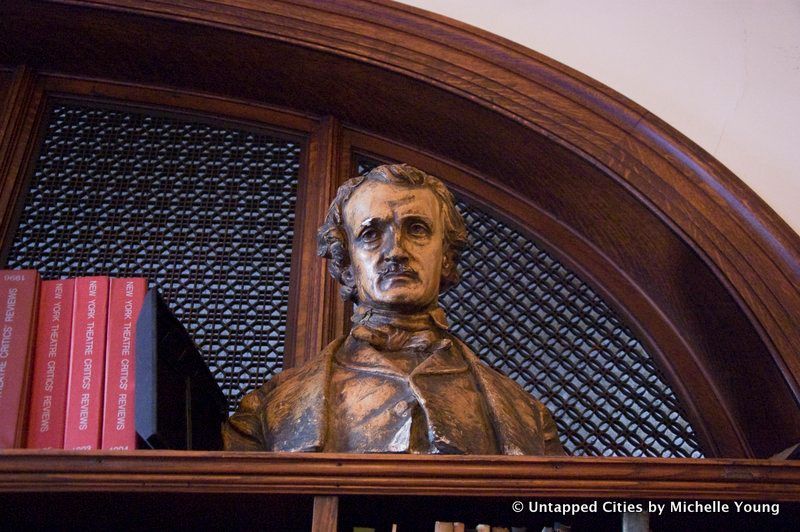
Edgar Allan Poe was born on January 19th, 1809 in Boston, Massachusetts, but many northeastern cities claim him as their own. Before his mysterious death in 1849, Poe lived in Richmond, Virginia, Boston, Massachusetts, Baltimore, Maryland, Philadelphia, Pennsylvania, and multiple places throughout New York. Despite having departed over a century and a half ago, Poe has not been forgotten. On this anniversary of his birthday, we take a look at 10 sites in New York City where you can remember the poet.
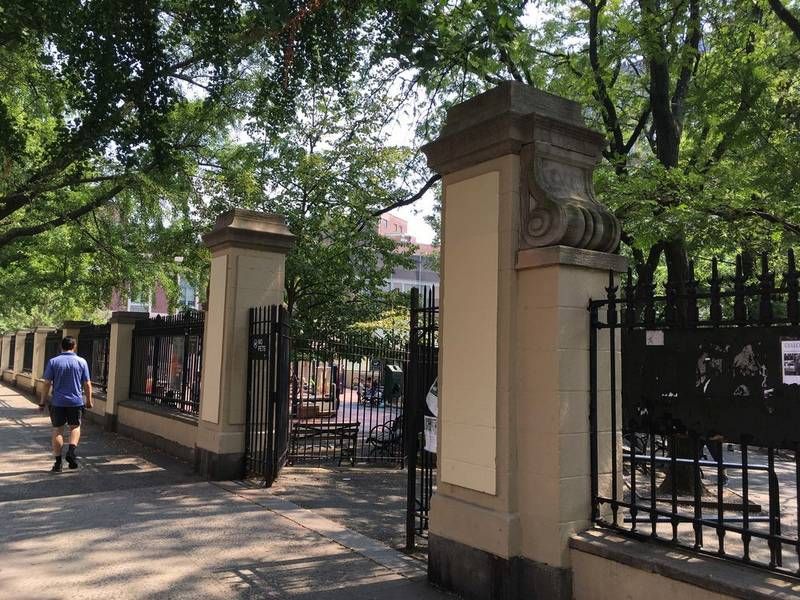
Poe first came to New York for a job at the New York Review, a literary magazine run by Francis Lister Hawks, in 1837. Poe, his young wife Virginia Clem, and her mother Maria Clem lived for a short time at the corner of Sixth Avenue and Waverly Place in Greenwich Village. They shared the home with bookseller William Gowans. Gowans later wrote of his impression of the Poe family from the eight short months they boarded together. During this time, Poe finished his only novel, “The Narrative of Arthur Gordon Pym,” which was released in 1838.
The Poes soon moved to 113 ½ Carmine Street. It is said that Poe and his wife enjoy frequent jaunts through St. John’s Cemetery, located on the east side of Hudson Street between Clarkson and Leroy Street, at the site of what is now James J. Walker Park. Poe didn’t publish much during his first stay in New York City and there is very little correspondence to or from him at this time. His move to New York coincided with the Panic of 1837 which led to a financial depression and the folding of the New York Review. With no job or means to make it in the big apple, Poe moved his family to Philadelphia in 1838.

When Poe returned to New York City in 1844, he lived in a variety of different places. One was a boarding house at 130 Greenwich Street. Another was a row house at 85 West Third Street, or Amity Street as it was in Poe’s time. The original structure no longer stands, but a replica of the facade can be found half a block away amongst the new buildings of NYU’s law school.
The facade, which is made up of all-new materials. was a compromise between preservationists and the University. Inside, a remnant of the original banister from Poe’s home has been preserved and members of the public are allowed to visit during a designated time. After moving around downtown, the Poes headed north to cleaner country air for the health of Poe’s ailing wife Virginia.
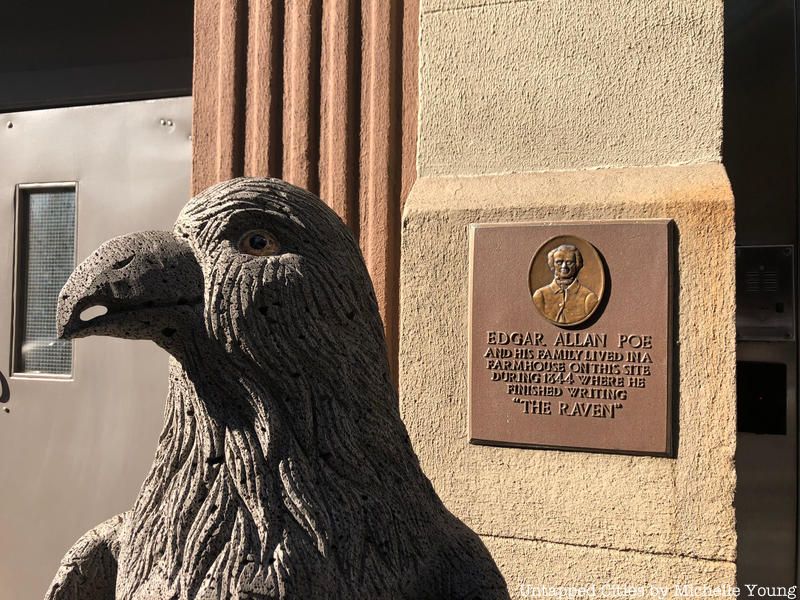
It is believed that Poe composed his famous poem The Raven while in residence at the Brennan Farmhouse, located at 84th and Broadway. Two competing plaques commemorate the site of the farmhouse. Both are located on 84th Street (with an honorary street name of Edgar Allan Poe Street) and Broadway, though one is east of Broadway and the other west.
The Raven was first published in an edition of The Evening Mirror, which was headquartered at 25 Ann Street in Manhattan. That building is now a residential structure that has been rechristened as the Edgar House. There is a plaque memorializing Poe in the building, but it is inaccessible to the general public.
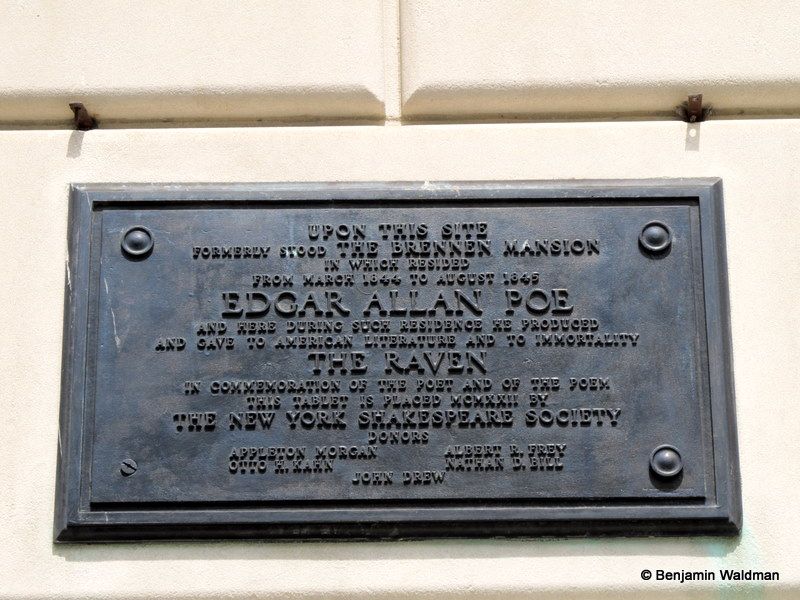
Poe took his wife and mother-in-law to live with Patrick Brennan, his wife, Mary Elizabeth, and their many children at the farmhouse, in hopes that the clean country air would help Virginia cope with her tuberculosis. The home stood atop a rocky outcropping and Poe enjoyed rambling on the grounds and taking in views of the Hudson River. He especially enjoyed a spot just inside Riverside Park that he dubbed Mount Tom, after one of the Brennan’s sons. While the rock remains, the wooden farmhouse was demolished in 1888.
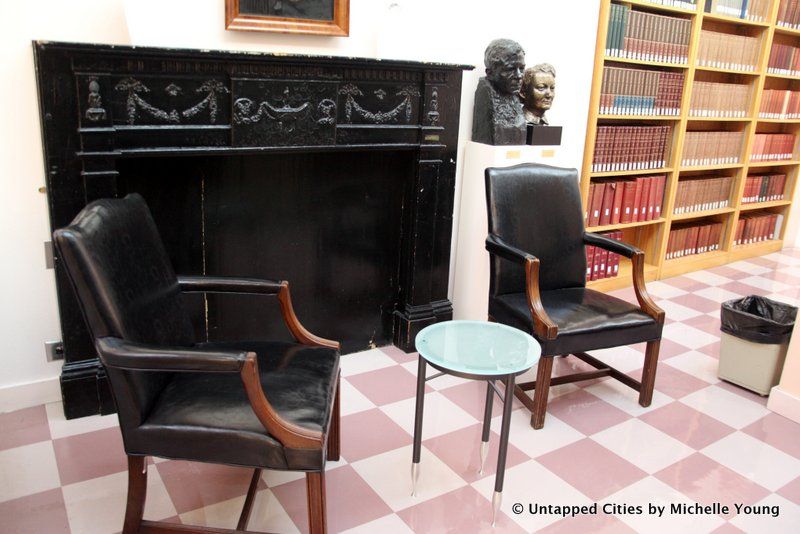
Located in Butler Library at Columbia University, the Raven Mantel is an architectural remnant of Poe’s room at the Brennan farmhouse. It was saved when the farmhouse was demolished because it had a cameo in the famous poem, The Raven. Poe even allegedly etched his initials into it. Check out our previous coverage of the mantel’s odyssey from the farmhouse to Columbia, where Untapped Cities discovered it lying fallow in a storage room.
After being unearthed from storage, the mantelpiece was later moved to a more visible location. Articles by Untapped staff in Columbia Magazine and The New York Times helped call attention to this architectural piece of literary history.
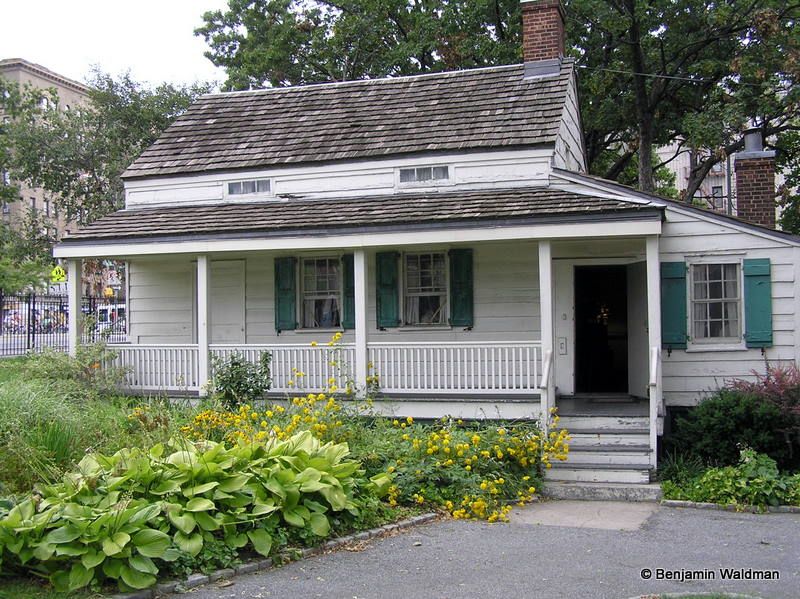
The Edgar Allan Poe Cottage was built in 1812 in what is now Fordham Manor. It was Poe’s final residence in New York City. Poe rented the cottage for $100 a year starting in the spring of 1846. Sadly, his beloved wife Virginia died in the home in 1847. Poe himself would die just two years later while in Baltimore. At the time of Poe’s death, his mother-in-law Maria Clemm moved out of the Bronx cottage. It is believed that Poe wrote his poems “Annabel Lee,” “The Bells,” and “Eureka” while living in the modest home. Though it has widely been reported that Poe enjoyed walks across the Harlem River along High Bridge while living in the Bronx, we debunked that myth – the walkway was completed after he died.
The house was saved by the efforts of the New York Shakespeare Society, which raised funds to have it moved across the street in 1913. The Shakespeare Society also put up the funds for one of the plaques at the site of the Brennan farmhouse. Today, the house is part of the Historic House Trust of New York City and has been administered by the Bronx Historical Society since 1975. It is a New York City and State landmark listed on the National Register of Historic Places. It is one of the Bronx’s most interesting house museums and one of the oldest structures in the borough. You can visit for a very small admission fee of $5!
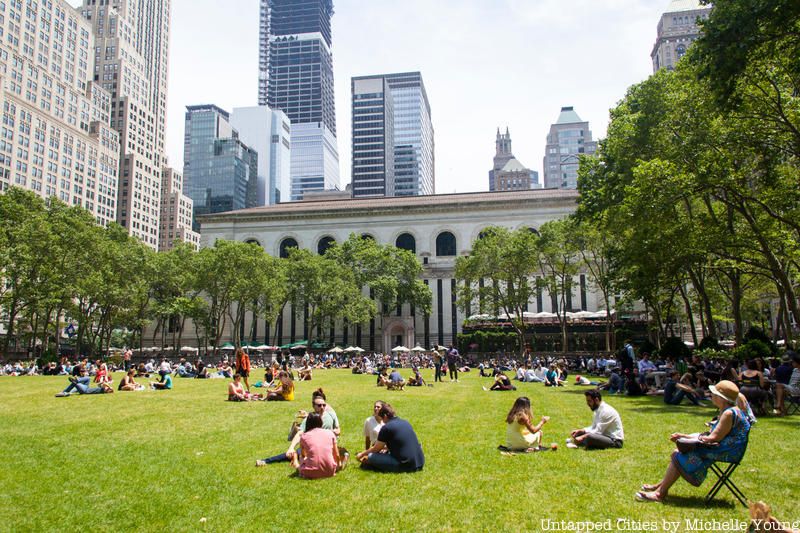
While Poe didn’t amble on solitary moonlit journeys across High Bridge, he did likely enjoy a stroll atop the Croton Distributing Reservoir which once stood where Bryant Park and the New York Public Library are today. The reservoir was part of the Croton Aqueduct system which delivered clean water to New York City. The reservoir was bounded by 40th and 42nd Streets and 5th and 6th Avenues. It opened in 1842.
In his Doings of Gotham column for the Columbia Spy in 1844, Poe wrote of the stunning view from atop the reservoir walls:
When you visit Gotham, you should ride out the Fifth Avenue, as far as the distributing reservoir, near forty-third street, I believe. The prospect from the walk around the reservoir, is particularly beautiful. You can see, from this elevation, the north reservoir at Yorkville; the whole city to the Battery; with a large portion of the harbor, and long reaches of the Hudson and East rivers. Perhaps even a finer view, however, is to be obtained from the summit of the white, light-house-looking shot-tower which stands on the East river, at fifty-fifth street, or thereabouts. The reservoir was demolished in 1900.

Many famous writers have spoken at The New York Society Library since it was established in 1754 (141 years before the public library system was created), including Edgar Allan Poe. He actually gave multiple lectures at the library. The first two were in January and April 1845. The topic of his talk was, fittingly, “Poets and Poetry of America.” It would be three years until he returned to the library to speak again.
In 1848, Poe’s lecture topic was very different. On February 3, 1848, on a stormy night, he presented a talk titled “The Cosmogony of the Universe.” “The core of Poe’s lecture was a new creation story, marked with strange and poetic mysteries,” that one person in attendance called a “rhapsody of the most intense brilliancy,” writes John Tresch in his book The Reason for the Darkness of the Night: Edgar Allan Poe and the Forging of American Science. The cosmic conclusions Poe discovered and lectured on at the library were put into a long prose poem, “Eureka,” which he published six months later. The strange, non-fiction text touched on many scientific discoveries and theories that would come in the 19th century.
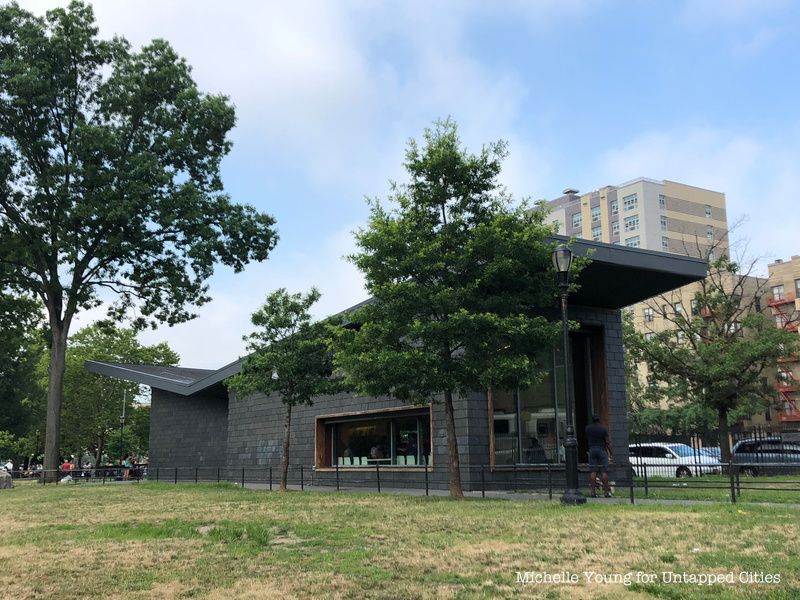
Poe Park is a public park that opened in the Bronx in 1902. The Poe Cottage was moved to the northern tip of the park from its original location across the street in 1913. In 2011, the cottage was joined by a modern visitor’s center designed by Toshiko Mori.
Mori took inspiration from Poe’s life and works when designing the striking dark gray building. She expresses the duality inherent in Poe’s work through two sections of the building, while the dramatic roofline is reminiscent of the wings of a raven. Slate shingles that cover the facade were traditionally used on the roofs of New England buildings. Inside the 2,700-square-foot building, visitors will find exhibition and assembly spaces, an information desk, and learning areas.
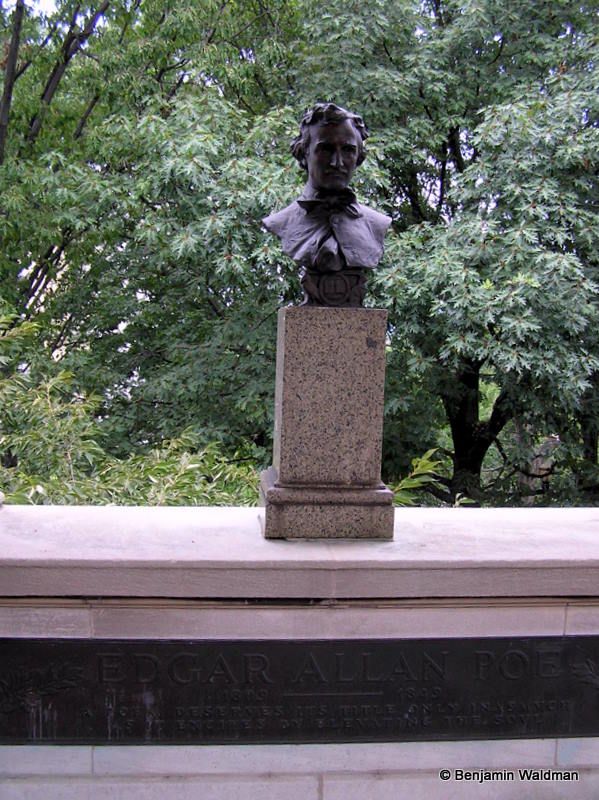
In 1910, Poe was inducted into the Hall of Fame of Great Americans located on New York University’s former Bronx campus (now Bronx Community College). Poe’s inclusion with the third class of inductees signifies how highly regarded he was. At the base of his bust, you can see a raven, an (assumedly black) cat, and an open book.
The Hall of Great Americans is a 630-foot open-air colonnade that rings the Gould Memorial Library. Designed by Stanford White, the colonnade is filled with 98 busts of famous Americans who were elected to be honored from 1900 to 1976. Poe keeps company with the likes of Alexander Graham Bell, Franklin D. Roosevelt, Susan B. Anthony, Abraham Lincoln, and George Washington among others.
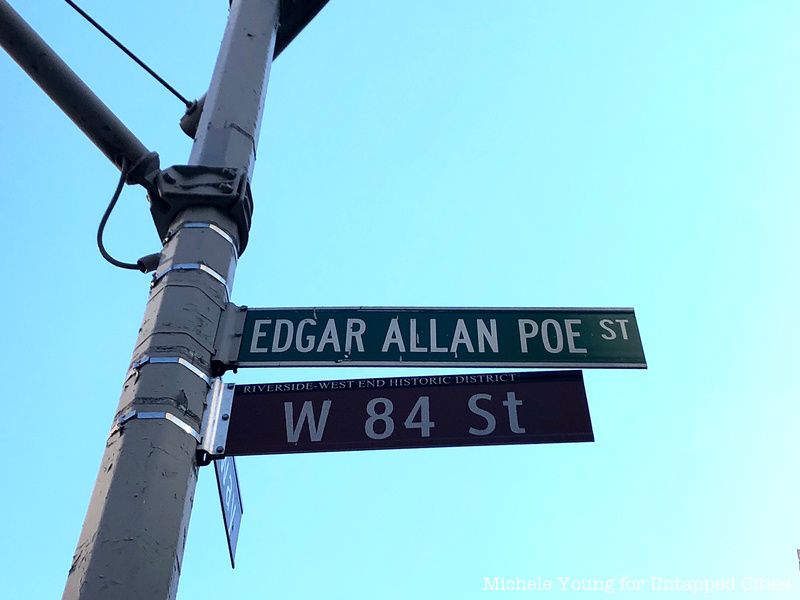
In 1980, the City memorialized Poe’s presence in the area by renaming West 84th Street, from Riverside Drive to Broadway, Edgar Allan Poe Street.
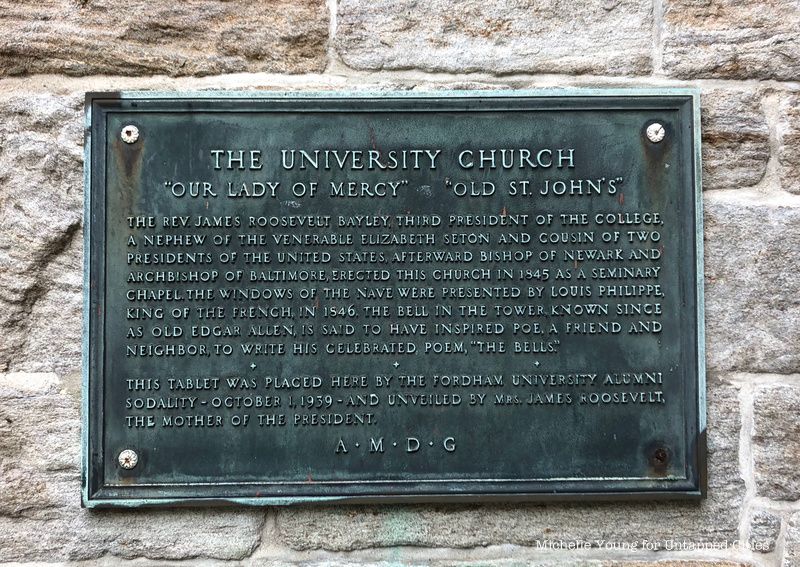
This plaque can be found at Fordham University whose church bell is thought to have inspired Poe’s poem, “The Bells.” The 19th-century bell, now in storage, was renamed Old Edgar Allan in Poe’s honor.
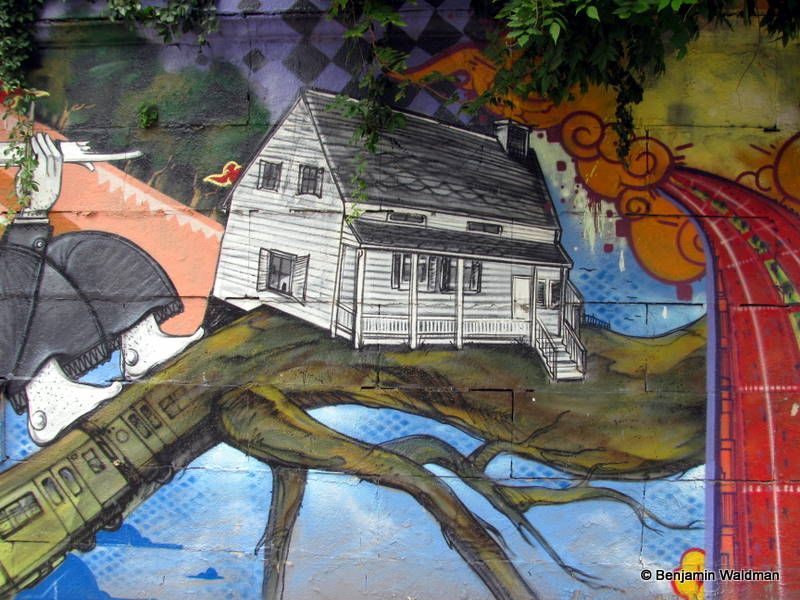
Even street art decorating the Grand Concourse in the Bronx commemorates Poe’s connection with the borough, depicting Poe’s cottage.
Next, read about The Farmhouse Where Edgar Allan Poe Wrote “The Raven” and 8 NYC Homes of Famous Writers
This article was originally written by Benjamin Waldman and updated by Nicole Saraniero
Subscribe to our newsletter